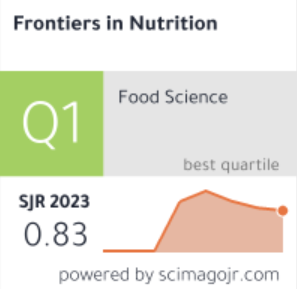Pica 与透析患者改变不良饮食和运动习惯的意愿较低、生活方式不足以及健康食物摄入量较少有关。
IF 4
2区 农林科学
Q2 NUTRITION & DIETETICS
引用次数: 0
摘要
背景在透析患者中,一方面,不愿意改变消极的生活方式与营养状况恶化和不健康的生活方式有关,另一方面,偏食可能非常普遍。然而,目前尚不清楚偏食是否与不愿改变不良生活方式以及食用不同类型的食物有关。本研究旨在调查这一问题。使用自制的生活方式测量问卷(IMEVID)对生活方式进行评估。根据《精神疾病诊断与统计手册》第五版确定了 Pica 诊断。结果与无偏食症的患者相比,偏食症患者(尤其是重度偏食症患者)改变不健康行为的意愿较低:在饮食方面(考虑前/考虑阶段分别为22%和46%),在运动方面(考虑前/考虑阶段分别为43%和62%)。在生活方式问卷的几乎所有维度上,硬性胃酸过多患者的得分都明显低于无胃酸过多组患者(p < 0.05):饮食(分别为 23.9 分和 26.8 分)、体力活动(分别为 5.5 分和 7 分)、疾病知识(分别为 5.7 分和 6.4 分)、情绪管理(分别为 6.6 分和 8 分)和坚持治疗(分别为 13.4 分和 14.7 分),但在烟酒消费方面则没有明显差异。与无胃酸过多的患者相比,胃酸过多的患者吃蔬菜和水果的频率较低,而吃乳制品、油炸食品和苏打水的频率较高。结论胃酸过多多见于改变饮食和运动不良习惯意愿较低的患者,在饮食、运动、情绪管理和坚持治疗方面有较多不健康行为的患者,以及吃健康食品频率较低而吃不健康食品频率较高的患者。本文章由计算机程序翻译,如有差异,请以英文原文为准。
Pica is associated with lower willingness to change negative habits of diet and exercise, inadequate lifestyle, and less healthful food consumption in dialysis
BackgroundIn dialysis patients, on the one hand unwillingness to change negative lifestyle patterns is associated with worse nutritional status and unhealthy lifestyle, whereas on the other, pica may be highly prevalent. However, it is not known whether pica is associated with unwillingness to change negative lifestyle behaviors, as well as with consumption of different types of foods. This study aimed to investigate this issue.MethodsThis is a cross-sectional study in dialysis patients. Lifestyle was assessed using the self-administered Instrument to Measure Lifestyle Questionnaire (IMEVID). Pica diagnosis was established according to the Diagnostic and Statistical Manual of Mental Disorders, Fifth Edition. A food frequency questionnaire was performed and self-reported willingness to change was determined by a trans-theoretical model staging inventory.ResultsCompared with patients without pica, those with pica (particularly hard pica) had lower willingness to change unhealthy behavior in the case of diet (22% vs. 46% in precontemplation/contemplation stages, respectively) and exercise (43% vs. 62% in precontemplation/contemplation stages, respectively). Patients with hard pica had significantly (p < 0.05) lower scores in almost all dimensions of the lifestyle questionnaire than those in the no pica group: diet (23.9 vs. 26.8, respectively), physical activity (5.5 vs. 7, respectively), knowledge of disease (5.7 vs. 6.4, respectively), emotion management (6.6 vs. 8, respectively) and adherence to treatment (13.4 vs. 14.7, respectively), but not in the consumption of tobacco and alcohol. Compared to patients with no pica, those with hard pica ate vegetables and fruits less frequently, and dairy products, fried foods and soda more frequently.ConclusionsPica was more frequently observed in patients with lower willingness to change negative habits of diet and exercise, in those who had more unhealthy behaviors in diet, exercise and emotion management dimensions and adherence to treatment, as well as in those who ate less frequently healthful foods and more frequently unhealthy foods.
求助全文
通过发布文献求助,成功后即可免费获取论文全文。
去求助
来源期刊

Frontiers in Nutrition
Agricultural and Biological Sciences-Food Science
CiteScore
5.20
自引率
8.00%
发文量
2891
审稿时长
12 weeks
期刊介绍:
No subject pertains more to human life than nutrition. The aim of Frontiers in Nutrition is to integrate major scientific disciplines in this vast field in order to address the most relevant and pertinent questions and developments. Our ambition is to create an integrated podium based on original research, clinical trials, and contemporary reviews to build a reputable knowledge forum in the domains of human health, dietary behaviors, agronomy & 21st century food science. Through the recognized open-access Frontiers platform we welcome manuscripts to our dedicated sections relating to different areas in the field of nutrition with a focus on human health.
Specialty sections in Frontiers in Nutrition include, for example, Clinical Nutrition, Nutrition & Sustainable Diets, Nutrition and Food Science Technology, Nutrition Methodology, Sport & Exercise Nutrition, Food Chemistry, and Nutritional Immunology. Based on the publication of rigorous scientific research, we thrive to achieve a visible impact on the global nutrition agenda addressing the grand challenges of our time, including obesity, malnutrition, hunger, food waste, sustainability and consumer health.
 求助内容:
求助内容: 应助结果提醒方式:
应助结果提醒方式:


